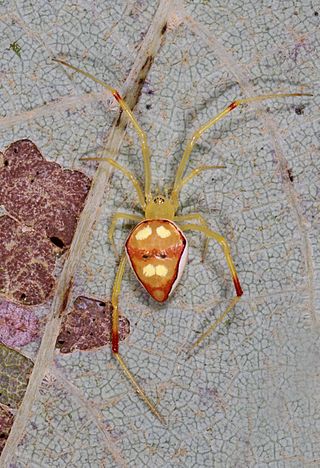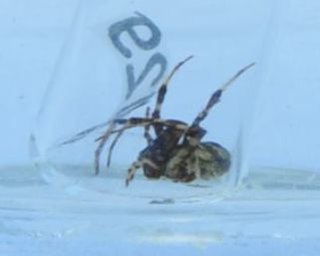
Latrodectus is a broadly distributed genus of spiders with several species that are commonly known as the true widows. This group is composed of those often loosely called black widow spiders, brown widow spiders, and similar spiders. However, the diversity of species is much greater. A member of the family Theridiidae, this genus contains 34 species, which include several North American "black widows". Besides these, North America also has the red widow Latrodectus bishopi and the brown widow Latrodectus geometricus, which, in addition to North America, has a much wider geographic distribution. Elsewhere, others include the European black widow, the Australian redback spider and the closely related New Zealand katipō, several different species in Southern Africa that can be called button spiders, and the South American black-widow spiders. Species vary widely in size. In most cases, the females are dark-coloured and can be readily identified by reddish markings on the central underside (ventral) abdomen, which are often hourglass-shaped.

Orb-weaver spiders are members of the spider family Araneidae. They are the most common group of builders of spiral wheel-shaped webs often found in gardens, fields, and forests. The English word "orb" can mean "circular", hence the English name of the group. Araneids have eight similar eyes, hairy or spiny legs, and no stridulating organs.

Barychelidae, also known as brushed trapdoor spiders, is a spider family with about 300 species in 39 genera.

Styposis is a genus of comb-footed spiders that was first described by Eugène Louis Simon in 1894. It is a senior synonym of Cyatholipulus.

Wirada is a genus of comb-footed spiders that was first described by Eugen von Keyserling in 1886.

The spider genus Spintharus occurs from the northeastern United States to Brazil. Nicholas Marcellus Hentz circumscribed the genus in 1850, initially as a monospecific genus containing his newly described species S. flavidus.

The spider genus Cabello consists of only one species, Cabello eugeni, found in Venezuela. It is a small yellow-white spider, with females 2 mm long, and males 1.6 mm. The eye region is reddish with a dusky median longitudinal band, the sternum whitish, with grey sides. The yellow-white legs have scattered black spots on the anterior face. On the abdomen there are scattered white spots.
Paratheridula is a monotypic genus of comb-footed spiders containing the single species, Paratheridula perniciosa. The sole species was first described in 1886 under the name Theridion perniciosum. The genus was first described by Herbert Walter Levi in 1957, though it has been described under several different names, including Mysmena 4-maculata, Theridion quadrimaculatum, and Theridion arcadicum,

Anelosimus is a cosmopolitan genus of cobweb spiders (Theridiidae), currently containing 74 species. Anelosimus is a key group in the study of sociality and its evolution in spiders. It contains species spanning the spectrum from solitary to highly social (quasisocial), with eight quasisocial species, far more than any other spider genus. Among these is the South American social species Anelosimus eximius, among the best studied social spider species.
Mastophora dizzydeani is a species of spider named after baseball player Dizzy Dean. Like all known species of the genus Mastophora, adult females are bolas spiders, capturing their prey with one or more sticky drops at the end of a single line of silk rather than in a web. Males and juvenile females capture their prey directly with their legs.

Cryptachaea is a genus of spiders in the Theridiidae family.

Parasteatoda is a genus of comb-footed spiders that was first described by Allan Frost Archer in 1946. The name is a combination of the Ancient Greek "para-" (παρά), meaning "near" or "next to", and the theridiid genus Steatoda. The Japanese name for this genus is O-himegumo zoku.

Mastophora, also known as bolas spiders, is a genus of orb-weaver spiders first described by E. L. Holmberg in 1876. They can be identified by a pair of lumps on the dorsal surface of the opisthosoma, though not all males will have these lumps.
Synotaxus is a genus of araneomorph spiders in the family Synotaxidae that was first described by Eugène Louis Simon in 1895. Originally placed with the tangle web spiders, it was moved to the family Synotaxidae in 2017.
Lewisepeira is a genus of orb-weaver spiders first described by Herbert Walter Levi in 1993.
Rubrepeira is a genus of orb-weaver spiders containing the single species, Rubrepeira rubronigra. It was first described by Herbert Walter Levi in 1992, found from Mexico to Brazil.

Hentziectypus is a genus of comb-footed spiders that was first described by Allan Frost Archer in 1946. Originally placed with Theridion, it was moved to Achaearanea in 1955, and to its own genus in 2008. These spiders most resemble members of Cryptachaea, but are distinguished by a median apophysis that is broadly attached to the tegulum. Spiders of Parasteatoda have a median apophysis attached to the embolus, while those of Achaearanea have a hooked paracymbium on the pedipalps of males.
Selkirkiella is a genus of South American comb-footed spiders that was first described by Lucien Berland in 1924. Originally placed with the Araneidae, it was transferred to the comb-footed spiders in 1972.

Gea eff is a species of orb-weaver spider. It is found in Papua New Guinea. The arachnologist Herbert Walter Levi formally described the species in 1983. While it was still undescribed, Michael H. Robinson and colleagues reported on its courtship and mating behaviors. Gea eff has the shortest scientific name of any spider species.












